A LIFELINE FOR FAMILIES

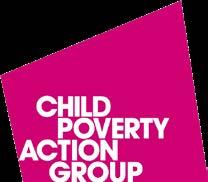
INVESTING TO REDUCE CHILD POVERTY THIS WINTER
Rachel Statham and Henry Parkes November 2022
ABOUT THE AUTHORS
Rachel Statham is associate director for work and the welfare state at IPPR.
Henry Parkes is a senior economist at IPPR.
ABOUT THIS PAPER
This briefing paper explores the fiscal, distributional and poverty impacts of different options for social security reform in light of the ongoing cost of living crisis, using the IPPR’s in house tax-benefit model.
ACKNOWLEDGEMENTS
The authors would like to thank Child Poverty Action Group and the TUC for their partnership on this report and contribution towards its funding. Thanks in particular to Anjum Klair and Kate Bell at the TUC, and Sara Ogilvie and Hannah Aldridge at CPAG.
Download
This document is available to download as a free PDF and in other formats at: http://www.ippr.org/publications/a lifeline for families
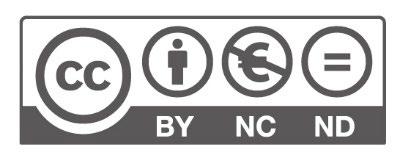
Citation
If you are using this document in your own writing, our preferred citation is: Statham R and Parkes H (2022) A lifeline for families: Investing to reduce child poverty this winter, IPPR, TUC and CPAG http://www.ippr.org/publications/a lifeline for families
Permission to share
This document is published under a creative commons licence: Attribution NonCommercial NoDerivs 2.0 UK http://creativecommons.org/licenses/by-nc-nd/2.0/uk/ For commercial use, please contact info@ippr.org
1. INTRODUCTION
The UK is in the grip of a living costs crisis. Despite unprecedented intervention to cap energy costs until April next year, typical household energy bills will have almost doubled on last year, while food prices have soared by 15 per cent (ONS 2022) and are set to rise further into early next year (IGD 2022). Ad hoc emergency financial support introduced by the UK government over the last year through one off cost of living payments has run dry, while prices continue to rise Nearly one in three children in the UK live in poverty and rates are set to rise to their highest level since the 1990s by the end of this parliament (Corlett and Try 2022).
Families with children are particularly vulnerable to rapid inflation. This is due to their additional food and fuel needs. However, emergency income support offered so far has been flat rate meaning each eligible household has received the same cash payment, regardless of household size. Millions more people have been pulled into debt and arrears in recent months and a growing number of children are going hungry as families are unable to meet basic costs with financial strain stretching further up the income spectrum towards middle income families (Schmuecker and Earwalker 2022; Butler 2022). At the same time, families with children are increasingly feeling the impact of punitive universal credit policies, as the combined impact of the unadjusted benefit cap and the two child limit are pulling more families into deeper poverty. Now, as we look towards the new chancellor Jeremy Hunt’s budget on 17th November, people struggling to make ends meet face continued uncertainty. Much of the recent policy debate has focussed on the government’s decision on whether to follow precedent and retrospectively uprate benefits with 2021/22 inflation rates in April next year. Maintaining the value of social security payments is vital but is the bare minimum option in a living standards crisis of the scale the UK is facing. Through the Covid-19 pandemic, the UK government recognised the need for additional support for those on the lowest incomes, as delivered through the £20 universal credit uplift which provided a lifeline through challenging economic circumstances. We are now entering an economic emergency of comparable proportions and there is a clear need for the new chancellor to intervene again to keep families afloat.
This is now a crisis that reaches farther up the income spectrum, spanning low and middle income families. In recent weeks, the UK government’s missteps have led to market turmoil that has pushed interest rates higher, and caused the value of the pound to plummet. These factors are now increasing financial pressure on households, both directly, as the cost of borrowing is rising alongside mortgage rates; and indirectly, as rising prices on imported goods from a weaker pound fuel further inflation. Without action, household incomes will be squeezed further. What remains of the UK government’s tax cuts most notably, the reversal of the health and social care levy, will make little difference to low and middle income families’ budgets, while those on the lowest incomes do not stand to benefit at all.
Child poverty is not inevitable, and children’s lives must not be the collateral damage of economic downturn. Instead, the new chancellor should recognise that investing in
3
IPPR, TUC and CPAG | A lifeline for families Investing to reduce child poverty this winter
children today is an investment in our future prosperity in every part of the UK. Without action, families on low and middle incomes will pay the price for the government’s mistakes through a deepening cost of living crisis this winter. The new chancellor has signalled his intention to cut back on public spending to reduce government debt as interest rates rise. But we believe this is the wrong path. After a decade of austerity that has eroded vital public services, there is simply nothing left to cut back on. Instead, we set out the case for investing in a lifeline for families with children through this winter, as part of a progressive approach to stabilising the economy through targeted investment for long term growth, increased taxes for those with the broadest shoulders, and emergency support to protect households from the worst of the cost of living crisis.
This is achievable despite the current economic challenges facing the UK. IPPR argues that the binding constraint for UK fiscal policy in the current macroeconomic environment is to avoid further fuelling inflation. Taking this approach, we find that there is fiscal space of between £90 £120 billion in 2023 (taking August 2022 as a baseline) (Jung and Roberts 2022). Taken alone, the measures recommended in this report would represent a low inflation risk. If the government chooses to use a greater share of this fiscal space (upwards of £90 billion) by combining these measures with other spending increases such as additional energy cost support, and protecting the value of departmental budgets there are options to keep inflation in check while supporting household incomes by ensuring that taxes play a bigger role in taking demand out of the economy (ibid). Taxation measures to be considered could include equalising taxes on earnings from work and wealth, extending the windfall tax on oil and gas companies, or introducing an annual wealth tax on assets over £10 million the latter alone could raise £16 billion annually (ibid).
Instead of further ad hoc support, families need certainty with which to plan for the winter ahead, and into next year. Our social security system can and should play a significant role in limiting hardship this winter, and in offering a lifeline to families for the future. This short paper sets out options to achieve that through reforms to universal credit and child benefit and their potential impacts, using the IPPR tax benefit model. It is on this basis that we make the case for additional household support, combined with revenue raising measures.
IPPR, TUC and CPAG | A lifeline for families Investing to reduce child poverty this winter
4
2.
REFORMING UNIVERSAL CREDIT
Households in receipt of universal credit receive a child element of this payment worth £245 per month per child, with an equivalent award under working tax credits. However, this support is limited to two children where subsequent children are born after April 2017. This means that families with three or more children receive the same amount of financial support through UC and legacy benefits as families with two children, despite their considerably higher costs
This two child limit drives poverty in large families which was already high and growing prior to the pandemic (McNeil and Parkes 2021), with analysis showing the policy to be the single biggest driver of child poverty in the UK (Reader et al 2022). Additionally, financial support from the government has typically been awarded on a household basis, not accounting for household composition, meaning that larger households have been short changed by existing support offers.
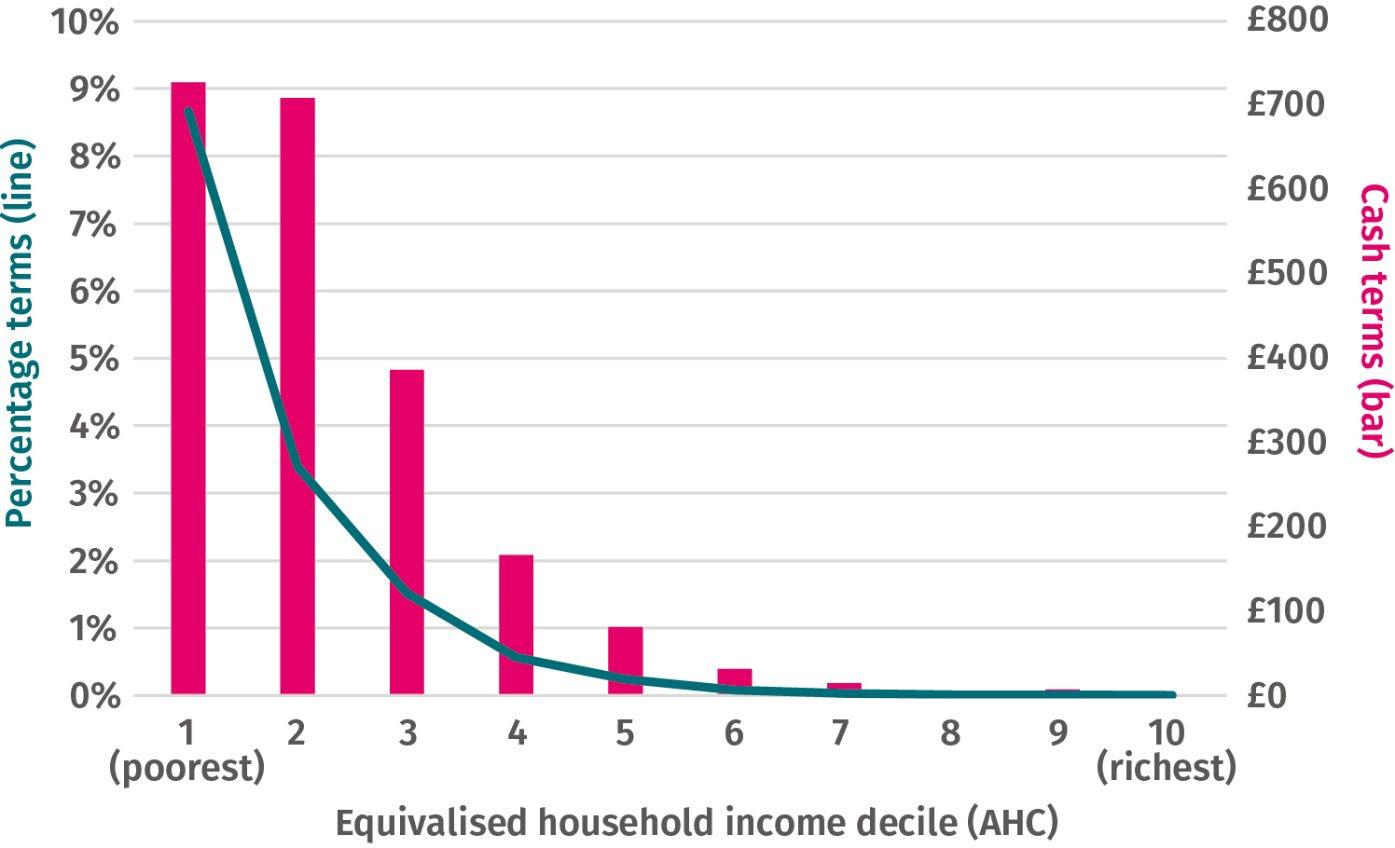
FIGURE 2.1: REMOVING THE TWO CHILD LIMIT AND BENEFIT CAP WOULD BE HIGHLY PROGRESSIVE AND TARGETED
Averageincomegrowthfromremovalofthetwo childlimitandbenefitcapbyequivalised householddecile(AHC)
Source: Authors’ analysis using the IPPR tax benefit model and DWP 2020
5
IPPR, TUC and CPAG | A lifeline for families Investing to reduce child poverty this winter
At the same time the benefit cap 1 limits overall benefit entitlement for out of work households and those with very low earnings. With levels of entitlement unchanged since 2017/18, the estimated 130,000 households on the cap will not receive a penny more from annual uprating come April 2022 despite spiralling costs.
There is a strong case for the removal of these policies, which our modelling estimates would cost £2.7 billion to scrap, but with significant poverty reducing effects, alleviating child poverty by 300,000. 2 Such changes would be highly progressive and channel financial support to some of the poorest in our society most hard pressed by the cost of living crisis.
There is also a case for boosting the child element of universal credit. Our modelling suggests that increasing the child element by £20/week per child (with equivalent increases in tax credits) on top of removing the caps would cost a further £5.1 billion for a total of £7.8 billion, reducing child poverty by a further 500,000 and overall poverty by an additional 600,000.
TABLE 2.1: COSTINGS AND IMPACTS
Cost in 2023/24 Child poverty reduction Total poverty reduction
Remove the two-child limit and benefit cap £2.7bn 300,000 500,000
Increase the child element of universal credit by £20/week (and equivalent in tax credits)
£4.3bn 300,000 500,000
Remove caps and increase rates £7.8bn 800,000 1,100,000
Source: Authors’ analysis using the IPPR tax benefit model and DWP 2020 Note: Due to significant interaction between removing the caps and increasing child elements, implementing both options have larger impacts and costs than pursuing either option individually. Figures refer to relative poverty rates after housing costs.
These options boost incomes amongst the poorest but have more limited impact amongst those on middle incomes and we know that families across the income distribution are likely to be suffering hence more universalist approaches may be warranted.
1 The benefit cap limits total household benefit receipt from across the social security system for households out of work or on low earnings, with some exceptions such as households with disabilities and caring responsibilities.
2 By poverty we mean ‘relative poverty’, which means people living in a household with income below 60 per cent of the UK median, after adjusting for household composition.
IPPR, TUC and CPAG | A lifeline for families Investing to reduce child poverty this winter
6
3.
BOOSTING CHILD BENEFIT
A more universalist approach to channelling income to families with children through the social security system would be through increases in child benefit.
Given the scale of the crisis and the likely range of households affected, child benefit offers a route to reach further up the income spectrum to families on low and middle incomes. Child benefit remains a reliable, well established income stream for low and middle income families across the UK, with the added benefit of very high take up rates, and greater reliability for families with fluctuating incomes. It remains relatively well targeted given that those on the highest incomes largely do not benefit following 2013 reforms 3 and is not affected by the two child limit.
FIGURE 3.1 INCREASING CHILD BENEFIT INCREASES INCOMES ACROSS THE INCOME DISTRIBUTION
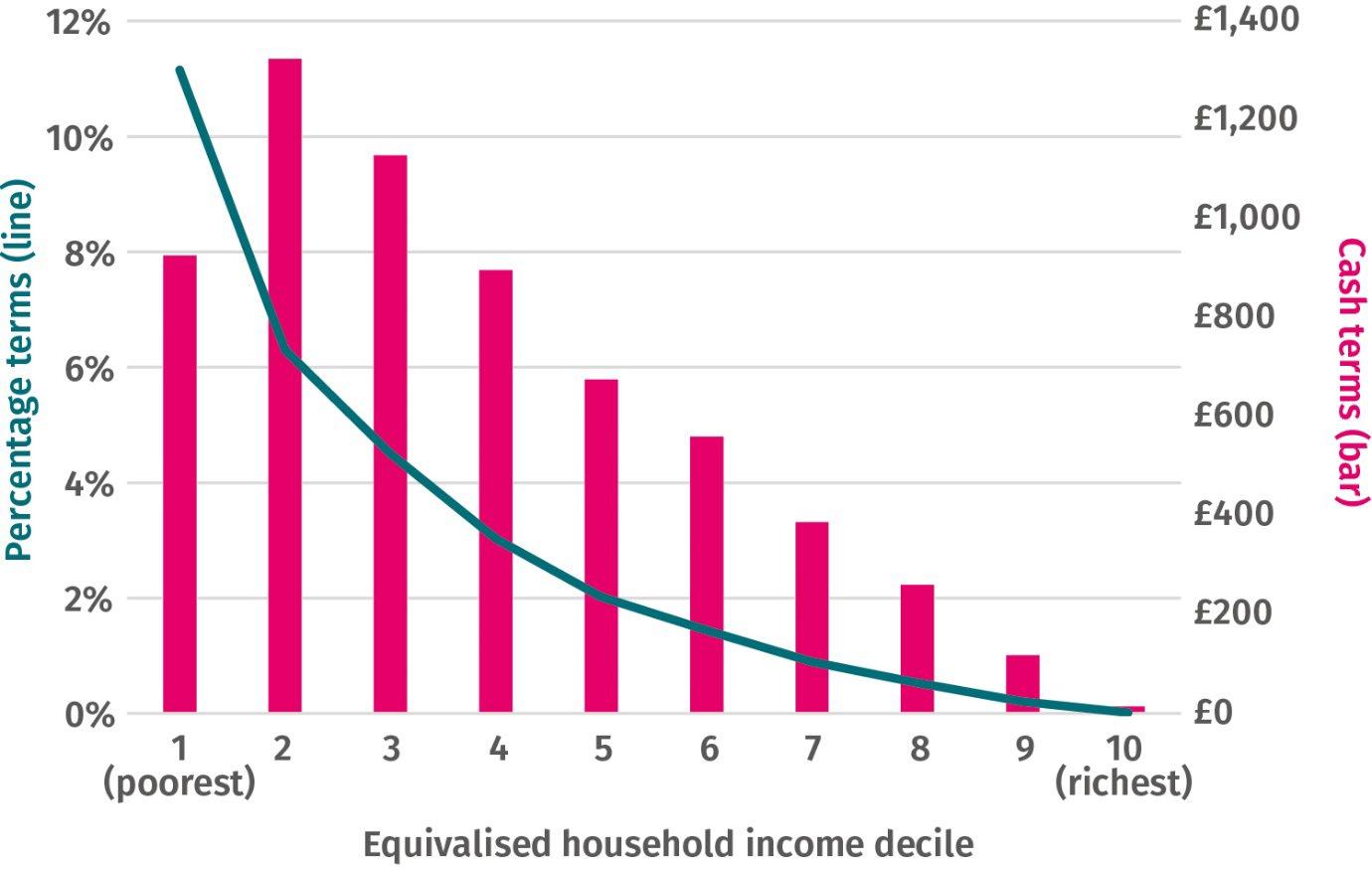
Averageincomegrowthfromboostingchildbenefitbyequivalisedhouseholdincome decile(AHC)
Source: Authors’ analysis using the IPPR tax benefit model and DWP 2020
3
Families where a parent earns £50,000 or more must pay a ‘high income child benefit charge’ equal to 1 per cent of child benefit for every £100 over the threshold, such that if an earner is paid £60,000 the entirety of Child Benefit is repayable through the charge
7
IPPR, TUC and CPAG | A lifeline for families Investing to reduce child poverty this winter
Since 2010, the value of child benefit has been significantly eroded. This has been driven by changes in how child benefit is increased over time, with a move from the Retail Price Index (RPI) to the consumer price index (CPI) to determine uprating followed by a series of freezes and increases below inflation. TUC analysis shows that had child benefit continued to rise with RPI since 2010/11, a family of two children would be over £600 better off in 2022/23 than they are today, with notional losses of over £4,000 since 2010/11.
We estimate that increasing child benefit by £20 per week per child would cost £9.9 billion, reduce child poverty by 500,000 and overall poverty by 700,000. But the benefits would go beyond just poverty alleviation and boost incomes more broadly while remaining broadly progressive.
TABLE 3.1: SUMMARY OF CHILD BENEFIT COSTINGS AND IMPACT
Cost in 2023/24 Child poverty reduction Total poverty reduction
Increase child benefit by £20/week per child
£9.9bn 500,000 700,000
Source: IPPR analysis using tax benefit model and DWP 2020
8
IPPR, TUC and CPAG | A lifeline for families Investing to reduce child poverty this winter
4.
RECOMMENDATIONS
People across the country are struggling to keep their heads above water in a deepening crisis. As the last of the flat rate, ad hoc emergency support reaches bank accounts this month, families across the country face deep uncertainty as we look towards the winter ahead, and the year that follows.
So far, it’s evident that government support has failed to go far enough for families with children, or to account for their increased exposure to rising costs. We also know that households across the income distribution are struggling to make ends meet. This points towards policy solutions that combine targeted reforms with a more universalist approach to income support
Without action, a winter of deepening hardship will cause lasting harm that stretches far into children’s futures, with significant social costs that will hold back the UK’s economic recovery over the long term.
There is an alternative. By investing in a lifeline for families, which could be funded by raising taxes on the financial 'winners' of the last few years, government policy could invest in children's futures while reducing the worst impacts on families on low and middle incomes. We recommend that this is supported by revenue raising measures that call on those with the broadest shoulders to pay their fair share which could include equalising taxes on earnings from work and wealth, extending the windfall tax on oil and gas companies, or introducing an annual wealth tax on assets over £10 million which alone could raise £16 billion annually (see Jung and Roberts 2022).
By introducing a package of support for families with children, the new chancellor can pave the way towards greater economic security in the short term, and a strong and shared economic recovery.
As such, we recommend that the UK government:
• increase child benefit by £20/week per child to provide a lifeline to families with children.
We estimate this would cost £9.9 billion per annum and reduce child poverty by 500,000 children in 2023/24 and lift 700,000 people out of poverty across the UK
In addition, we recommend that the UK government:
• remove the two child limit, now the single biggest driver of UK child poverty, and
• remove the benefit cap to prevent families from being pulled into deeper poverty and ensure all families can benefit from uprating in April 2023.
9
IPPR, TUC and CPAG | A lifeline for families Investing to reduce child poverty this winter
We estimate this would cost around £2.7 billion and would lift 300,000 children out of poverty in 2023/24, and 500,000 people overall.
Taken together these policies would provide a substantial boost to the incomes of the poorest families, lifting over a million people out of poverty, while also channelling financial support to families towards the middle of the income distribution who also face a substantial squeeze on their finances.
TABLE 4.1: SUMMARY OF PROPOSED CHANGES AND IMPACT
Cost Child poverty reduction Total poverty reduction
Increase child benefit by £20/week per child £9.9bn 500,000 700,000
Remove the two-child limit and benefit cap £2.7bn 300,000 500,000
Remove caps and increase child benefit by £20/week per child £12.9bn 900,000 1,200,000
Source: Authors’ analysis using the IPPR tax benefit model and DWP 2020 Note: Poverty figures are rounded to the nearest 100,000. Totals may not sum due to rounding. The two policy changes interact meaning the effect and costs of doing both policies can exceed that of doing the policies individually.
TABLE 4.2: THESE MEASURES WOULD HAVE THE GREATEST IMPACT IN THE WEST MIDLANDS, AND YORKSHIRE AND THE HUMBER, WHERE AVERAGE HOUSEHOLD INCOMES WOULD GROW BY NEARLY 3 PER CENT
Averageincomegrowthandpovertyreductionfromproposedpolicychanges,bynationor region
Government office region
Average income growth
Child poverty reduction Total poverty reduction
South East 1.5% 90,000 110,000 Scotland 1.7% 40,000 50,000
East of England 1.7% 80,000 120,000
London 1.8% 130,000 180,000
South West 2.0% 50,000 70,000
East Midlands 2.3% 60,000 80,000
Wales 2.5% 60,000 80,000 North West 2.6% 110,000 160,000
IPPR, TUC and CPAG | A lifeline for families Investing to reduce child poverty this winter
10
Northern Ireland 2.6% 20,000 30,000
North East 2.7% 50,000 70,000
West Midlands 2.8% 100,000 130,000 Yorkshire and the Humber 2.8% 90,000 120,000
Source: IPPR analysis using IPPR tax benefit model and DWP 2020 2019 2018
We also find implementing these two policies would boost incomes in some places more than others, with the greatest increases in average income in Yorkshire and the Humber, the West Midlands and the north east of England.
FIGURE 4.1: OUR REFORMS WOULD BE PROGRESSIVE
Averageincomegrowthfromproposedpolicychangesbyequivalisedhouseholdincome decile(AHC)
Source: Authors’ analysis using the IPPR tax benefit model and DWP 2020 2019 2018
At this crucial time, government must face up to the unprecedented and growing challenges faced by households with children to prevent further hardship and strengthen the social safety net.
IPPR, TUC and CPAG | A lifeline for families Investing to reduce child poverty this winter
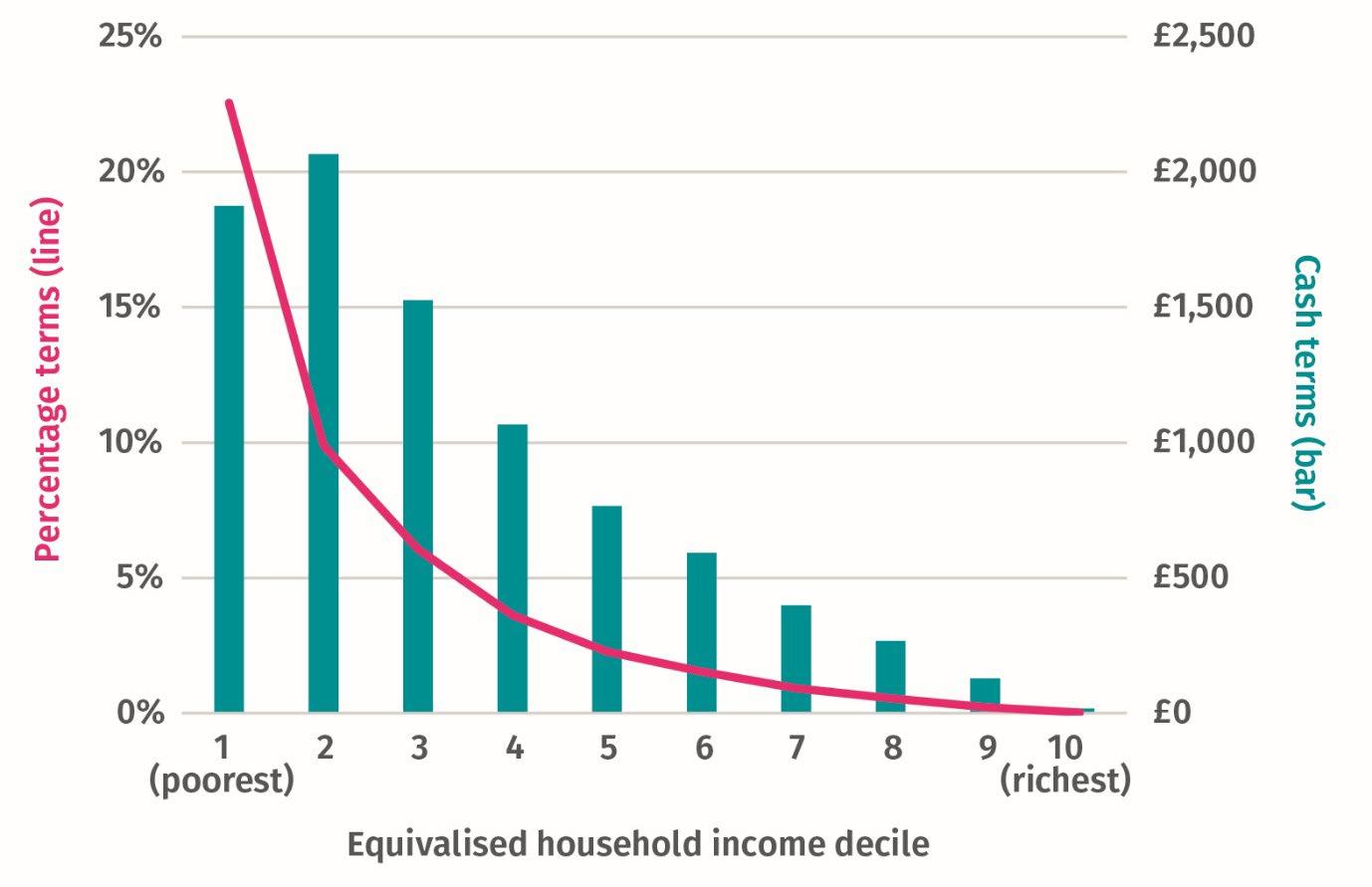
11
REFERENCES
Butler P (2022) ‘Millions forced to skip meals as UK cost of living crisis deepens’, Guardian. https://www.theguardian.com/society/2022/oct/18/millions forced to-skip-meals-as-uk-cost-of living-crisis-deepens
Department for Work and Pensions [DWP] (2020) Family Resources Survey 2019/20, dataset. Accessible via UK Data Service
Department for Work and Pensions [DWP] (2019) Family Resources Survey 2018/19, dataset. Accessible via UK Data Service
Department for Work and Pensions [DWP] (2018) Family Resources Survey 2017/18, dataset. Accessible via UK Data Service
Department for Work and Pensions [DWP] (2022) ‘Benefit cap: Number of households capped to May 2022’, dataset https://www.gov.uk/government/statistics/benefit-cap-number of households capped to may 2022
Institute of Grocery Distribution [IGD] (2022) ‘Food inflation rate to peak in early 2023, then slow’, press release. https://www.igd.com/home/article-viewer/t/food-inflation-rate to peak in-early2023 then slow
Schmuecker K and Earwalker R (2022) Not heating, eating or meeting bills: managing a cost of living crisis on a low income, JRF https://www.jrf.org.uk/report/not-heating-eating or-meeting-bills managing-cost living-crisis-low income
His Majesty’s Treasury [HMT] (2022) ‘Chancellor announces new Growth Plan with biggest package of tax cuts in generations’, news article. https://www.gov.uk/government/news/chancellor announces new growth plan with biggest package of tax cuts in-generations
McNeil C and Parkes H (2021) No longer ‘managing’: The rise of working poverty and fixing Britain's broken social settlement. https://www.ippr.org/research/publications/no longer-managing the rise-of-working-poverty and-fixing-britain-s-broken-social-settlement
Reader M, Portes J and Patrick R (2022) Does cutting child benefits reduce fertility in larger families? Evidence from the UK’s two child limit, Benefit Changes and Larger Families project. https://largerfamilies.study/publications/does-cutting child-benefits-reduce-fertility-in-largerfamilies-evidence-from-the-uk-s-two child/
Office for National Statistics (ONS 2022) ‘Consumer Price Inflation, UK: September 2022’, statistical bulletin. https://www.ons.gov.uk/economy/inflationandpriceindices/bulletins/consumerpriceinflation/sept ember2022
IPPR, TUC and CPAG | A lifeline for families Investing to reduce child poverty this winter
12
IPPR, TUC and CPAG | A lifeline for families Investing to reduce child poverty this winter
13
ABOUT IPPR
IPPR, the Institute for Public Policy Research, is the UK’s leading progressive think tank. We are an independent charitable organisation with our main offices in London. IPPR North, IPPR’s dedicated think tank for the North of England, operates out of offices in Manchester and Newcastle, and IPPR Scotland, our dedicated think tank for Scotland, is based in Edinburgh. Our purpose is to conduct and promote research into, and the education of the public in, the economic, social and political sciences, science and technology, the voluntary sector and social enterprise, public services, and industry and commerce.
IPPR 14 Buckingham Street London WC2N 6DF T: +44 (0)20 7470 6100 E: info@ippr.org www.ippr.org Registered charity no: 800065 (England and Wales), SC046557 (Scotland)
This paper was first published in November 2022. © IPPR 2022 The contents and opinions expressed in this paper are those of the authors only.
The progressive policy think tank






